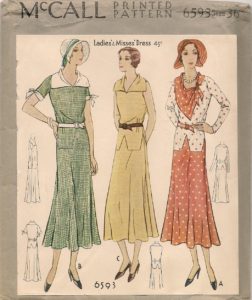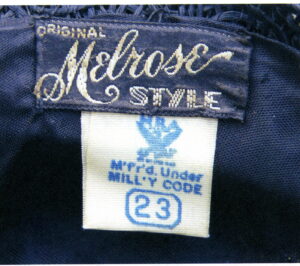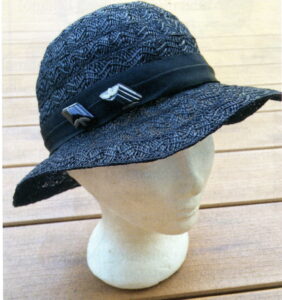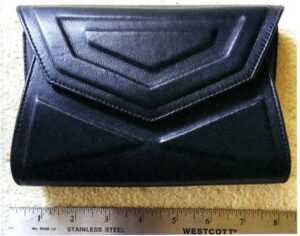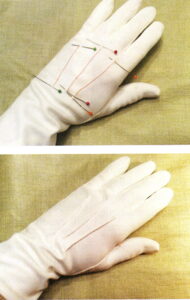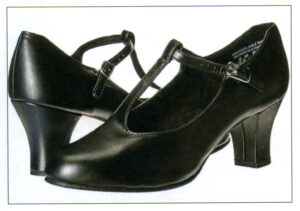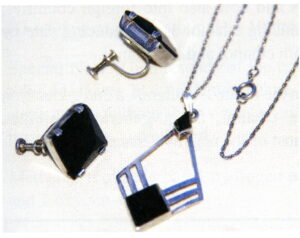The Road to a Perfect ”Clara” Award –
Reproduction Category
by Chris Aupperle, MARC Fashion Committee
Our antique car hobby and its distinctive fashions are 91 years old this year. This does not bode well for collectors of vintage clothing, let alone a person who loves to actually wear vintage fashions! Cotton, silk, wool and rayon can withstand the test of time, but often do not because of a previous owners’ lack of care. But it is a joy to come across vintage garments which have been carefully preserved, cleaned and stored. Usually, we usually don’t have provenance or histories of the dresses, shoes, purses and hats we find online or in antique stores. As garments age, they can deteriorate and then only be used for display or historical purposes. Thus the need for reproducing an authentic ensemble!
The pursuit of an accurate representation of a historic fashion ensemble requires considerable careful research, study, shopping, sewing skill and determination. Consider yourself as a historic re-enactor; one who looks as though they have just stepped out of a bygone era. With this in mind, and a healthy dose of hard-nosed, self-criticism, it is possible to create the perfect look from 1928 – I 931.
For reproducing a woman’s ensemble, it is best to start with the major garment – a dress, suit or sportswear. Using the MARC Model A Era Fashion Standards 1928-1931 is absolutely essential. Here is where you can compare vintage online patterns with what is correct for the era. However, MARC’s Pattern Project (Pattern Project – Model A Restorers Club (model-a-ford.org) ) has carefully restored 28 vintage patterns dated 1928 to 1931 and that is a great place to begin your search. If using patterns from other sources, be sure to compare their styles with the MARC Model A Era Fashion Standards 1928-1931 book. Do not trust sellers unless the date has been printed on the pattern or you can validate the pattern number with the year published (see witness2fashion.com/ or www.cemetarian.com/ or other reputable sites and resources).
Now that an era pattern has been selected and sized to fit, carefully study the colors and fabrics used in the pattern. If the pattern envelope or other reference shows a color image of the garment, pay close attention. That image provides valuable information to create a garment with an authentic look. It is best not to alter or add flourishes to the pattern, but use it exactly as is. Era fabrics were cotton, wool, silk and rayon in various weights and finishes. A cotton daytime dress needs a light flowing “hand”, so cotton lawn can be a good choice. Late afternoon tea or formal dresses were typically made of a very lightweight fabric like chiffon or voile. Fall and Winter fabrics were wool, some heavier silks and rayon. Local fabric stores might have a few good options, but online stores will sell you a small swatch of your selection prior to purchase. Matching colors in a dress makes this essential. Research those Era colors and prints online and in verifiable resources so that you do not make your garment of a more modern color or print. A lovely, well-made reproduction garment will go a long way in wear and use. As your garment begins to take shape, periodically check for fit and finish – it needs to look good on you! Some fashions lend themselves to a mature figure and others are meant for a slimmer build. Please remember that ladies’ dresses generally had a loose and boyish fit, but not overwhelmingly loose or tight. If the fabric pulls anywhere across your body, it’s not a good fit and you won’t look your best. If you are tall, be sure to allow extra inches at the hem so that the length is correct for the year. The same is true if you are short. Dresses from 1928 were at the knee. In 1931, dresses were quite long – closer to the ankle than to the knee. Era undergarments generally consisted of tap pants, a bandeau brassiere and a full slip. Find patterns online or sew a copy from an original item. If you make your own, you’ll generally only need one set for any future reproduction ensembles. Select a nice, sturdy but soft cotton for the bandeau brassiere and silk or cotton for the tap pants. Era colors were solid white, flesh or pale pink/peach. If you decide to wear rolled stockings, you won’t need a garter belt, but beware: improperly fitting stockings can droop and bunch at the ankles – not a neat look. A reproduction-made garter belt results in a better fit for your hosiery, but can be uncomfortable. We ladies are used to wearing pantyhose and comfy leggings these days. Seamed hosiery is still available (look for the Berkshire brand), but choose tan or light brown seams, not racy black!
If your dress is for day wear or afternoon tea, you’ll need a hat, of course.
Choose a style (e.g. cloche, poke, helmet, brim) best for your face and your major garment. Consider fabric content to complement the dress fabric (wool, straw, cotton, silk). Hat color should blend or complement the main color of the dress. It is possible to find a hat online, but remember that it must be constructed after the Era to most closely resemble the Era. Hats made in 1932-33 would have the National Recovery Act label and could complete your look quite nicely, but be sure they still have the Era look. If you want to try your hand at sewing your own hat, there are plenty of cloche and small brimmed Era hat patterns online as well. You can also re-style a
modern hat for the Era. For example, a flexible lightweight brimmed straw hat can be folded, sewn and shaped to resemble a bi-com or tri-com hat from the early 1930s. Women did occasionally wear hats for formal events, but for judging purposes, it’s generally a safe bet to have an Era hairdo for that formal look. You might even consider a small barrette or decorative comb to enhance your styled hairdo. What woman doesn’t own a purse? In the years 1928 – 1931, purses were generally small, compact and relatively flat, intended to carry what women back then considered essentials: a lipstick, a compact, comb, mirror, and handkerchief. Many leather
bags had a vertical strap on the back. Formalwear purses might be made of metal mesh, brocade fabrics, satins, velveteen or crepe. Purses and shoes did not necessarily have to match, but this Era trend was seen more often than not. It is still possible to find the perfect purse in antique stores and online, Be aware that purses with larger dimensions have a 1940s look, not appropriate for reenacting our Era. Consult the MARC Model A Era Fashion Standards 1928-1931 when you shop!
Fabric and leather gloves from the Era had three decorative lines of stitching on the back/top of the glove, sometimes known as gores. It is possible to sew that on a modern glove to make it look as an original. (see photos)
Shoes should be made of leather for day/ afternoon wear or possibly satin for evening wear. Daytime dresses look best with a mid-rise classic heel profile. Capezio is a company which still produces a t-strap and “Mary Jane” styles. Fabric and canvas were materials used in very casual, sporting or beach shoes.
Jewelry is the perfect finishing touch to any ensemble and is judged for
historic reproduction accuracy as well. Remember that there were no Era earrings with clip backs. Aurora borealis stones were not in existence at that time. Necklaces and bracelets had no lobster claw fastenings. Choose a necklace with a simple spring ring clasp. It is possible to bead your own earrings, pendant necklace, and bracelet or find appropriate Era substitutes online. Colors should complement and not add additional details to your total look. Refer to the MARC Model A Era Fashion Standards 1928-1931 jewelry section.
The best advice when putting together
an Era reproduction ensemble is to keep it simple. Less is more. Ask for a Fashion Committee Mentor who can provide helpful guidance and encouragement. Enjoy the challenge and have fun in the process. Good luck!
Used with permission from Model “A” News September-October 2019

